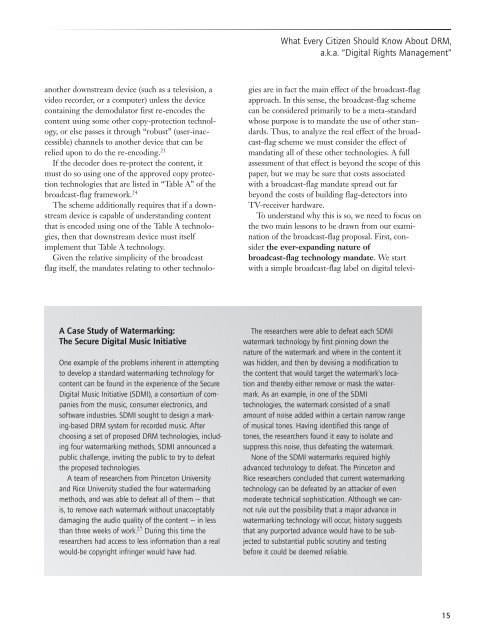What Every Citizen Should Know About DRM, aka - Public Knowledge
What Every Citizen Should Know About DRM, aka - Public Knowledge
What Every Citizen Should Know About DRM, aka - Public Knowledge
Create successful ePaper yourself
Turn your PDF publications into a flip-book with our unique Google optimized e-Paper software.
<strong>What</strong> <strong>Every</strong> <strong>Citizen</strong> <strong>Should</strong> <strong>Know</strong> <strong>About</strong> <strong>DRM</strong>,a.k.a. “Digital Rights Management”another downstream device (such as a television, avideo recorder, or a computer) unless the devicecontaining the demodulator first re-encodes thecontent using some other copy-protection technology,or else passes it through “robust” (user-inaccessible)channels to another device that can berelied upon to do the re-encoding. 23If the decoder does re-protect the content, itmust do so using one of the approved copy protectiontechnologies that are listed in “Table A” of thebroadcast-flag framework. 24The scheme additionally requires that if a downstreamdevice is capable of understanding contentthat is encoded using one of the Table A technologies,then that downstream device must itselfimplement that Table A technology.Given the relative simplicity of the broadcastflag itself, the mandates relating to other technolo-gies are in fact the main effect of the broadcast-flagapproach. In this sense, the broadcast-flag schemecan be considered primarily to be a meta-standardwhose purpose is to mandate the use of other standards.Thus, to analyze the real effect of the broadcast-flagscheme we must consider the effect ofmandating all of these other technologies. A fullassessment of that effect is beyond the scope of thispaper, but we may be sure that costs associatedwith a broadcast-flag mandate spread out farbeyond the costs of building flag-detectors intoTV-receiver hardware.To understand why this is so, we need to focus onthe two main lessons to be drawn from our examinationof the broadcast-flag proposal. First, considerthe ever-expanding nature ofbroadcast-flag technology mandate. We startwith a simple broadcast-flag label on digital televi-A Case Study of Watermarking:The Secure Digital Music InitiativeOne example of the problems inherent in attemptingto develop a standard watermarking technology forcontent can be found in the experience of the SecureDigital Music Initiative (SDMI), a consortium of companiesfrom the music, consumer electronics, andsoftware industries. SDMI sought to design a marking-based<strong>DRM</strong> system for recorded music. Afterchoosing a set of proposed <strong>DRM</strong> technologies, includingfour watermarking methods, SDMI announced apublic challenge, inviting the public to try to defeatthe proposed technologies.A team of researchers from Princeton Universityand Rice University studied the four watermarkingmethods, and was able to defeat all of them — thatis, to remove each watermark without unacceptablydamaging the audio quality of the content — in lessthan three weeks of work. 27 During this time theresearchers had access to less information than a realwould-be copyright infringer would have had.The researchers were able to defeat each SDMIwatermark technology by first pinning down thenature of the watermark and where in the content itwas hidden, and then by devising a modification tothe content that would target the watermark’s locationand thereby either remove or mask the watermark.As an example, in one of the SDMItechnologies, the watermark consisted of a smallamount of noise added within a certain narrow rangeof musical tones. Having identified this range oftones, the researchers found it easy to isolate andsuppress this noise, thus defeating the watermark.None of the SDMI watermarks required highlyadvanced technology to defeat. The Princeton andRice researchers concluded that current watermarkingtechnology can be defeated by an attacker of evenmoderate technical sophistication. Although we cannotrule out the possibility that a major advance inwatermarking technology will occur, history suggeststhat any purported advance would have to be subjectedto substantial public scrutiny and testingbefore it could be deemed reliable.15





